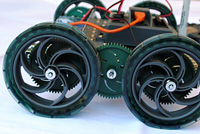Robot Engineering: Tapping the Artist within the Bot
When it comes to customizing robots, the spirit of innovation is alive and well in afterschool programs around the country. Extracurricular engineering and robotics clubs may provide a welcome outlet and important mentoring for students. From brainstorming designs to nuts and bolts building to learning how to integrate servo motors and computer programming, robotics projects capitalize on a student's love of tinkering—with the possibility of a clear reward in the end, a bot that does what you want it to do. A new trio of Science Buddies robotics engineering Projects Ideas offer students blueprints for hands-on exploration. Whether it is a student's first robot or merely the next, these projects offer independent challenge for at-home innovation or for a science and engineering design project assignment.

Engineers of all ages are often intrigued by the challenge of creating a robot that can make art. Some art bots are designed to duplicate or recreate a given image. Some draw pre-defined shapes or images. Some follow in the footprints of famous abstract expressionists. With new robotics engineering projects at Science Buddies, students can use the VEX system to design a robot that can draw. With the Engineering Design Process and Science Buddies Project Ideas as a guide, what kind of art bot will you build?
An Art Automaton
Did you read or see The Invention of Hugo Cabret with your family? Did you marvel over and wonder about the mysterious automaton that Hugo's father, and later Hugo, work to repair? The automaton in Hugo Cabret is designed to write or draw something, and seeing what the machine does when Hugo successfully restores it and inserts the heart-shaped key is part of the intrigue of the story by Brian Selznik. Automata (more than one automaton) belong to a category of engineering in which a non-electric machine is created to perform an automated task. These machines, often made out of complicated clockworks, are a form of robotics.
LEGO® Robotics
In addition to VEX robotics systems, students can also explore robotics using LEGO® Mindstorms®. The new "X Marks the Spot: Build a Robot to Protect Your Treasures" robotics Project Idea challenges students with a Mindstorms system to build and program a robot sentry to guard and protect a designated space.
Engineering Steps
When an elementary school student watches a mechanical bot crawl across the table and notices that if she presses and holds both of the micro-controller buttons at once, the insect will crawl in a circle rather than in straight lines, what happens next? Maybe she experiments with each button separately. Maybe she evaluates the difference in the bot's speed based on how she uses the buttons. Maybe she sees the circular shape of the bot's movement and realizes it could potentially draw a circle.
The insect doesn't really have anything to do with drawing or markers. It's just a tiny bug version of a classic remote-controlled toy car. It is an upgrade over last year's bug, however. That one just had an on and off switch. Once on, it moved without stopping. This model has given her control over the movement. In testing that control, she's made a hypothetical leap. When the student sees the circle and makes a connection to something else that can be done by combining the bug's motions and another implement (a marker), there is magic. Testing her idea by wedging a marker through the bug's appendages and setting it loose on top of a piece of paper may, in fact, generate a circle. If it takes several tries to find the right angle at which to position the marker, or just how far you need to stick it through the bug's legs, that's part of the process. Similarly, pens and markers of different weights may work differently&mddash;or may not work at all. The bug is small and lightweight. That has an impact on what kind of marking instrument the bug can drag along in its circuitous path. But, finally, there is a circle. A circle that a small bug robot has drawn.
In this case, the ability to control the drawing process is limited. But for many parents and teachers, the simple "aha" moment, and the satisfaction of seeing the circle on the page, is an important part of science, technology, engineering, and math (STEM) education. To feed this kind of excitement about engineering, robotics clubs and groups are springing up in an increasing number of schools and after-school programs, often with the support of companies like Motorola Solutions Foundation. Many of these groups work with VEX robotics kits. Part screw-it-together, part brainstorm and modify, part hacker DIY, part programming, and part collaboration with peers and clusters of parents, teachers, and role models, VEX systems can be a fulcrum for middle and high school robotics exploration.
For the Game of It
This year, student robotics teams planning to participate in VEX competitions are preparing for the VEX Sack Attack. To succeed in the Sack Attack challenge, teams will have to design and build a bot that can quickly and efficiently scoop up "sacks" and deposit them in a scoring area to earn more points for the team than the bot on the other side of the 12' x 12' arena within a set amount of time. Different colored sacks earn different points, and there are multiple types of goals, each worth different point values. In preparation for an official bot versus bot Sack Attack showdown, robotics team members often meet in the afternoons and on weekends. Many teams, especially at the middle school level, first assemble a baseline or "kit" sack attack bot. The "kit" bot is functional, but as groups test and observe their bots abilities, they are encouraged to think about ways to enhance the bot's ability to quickly and efficiently perform its task. Following steps of the Engineering Design Process, students collaborate customizing their robot and prototyping and testing new features, behaviors, and programming. What modifications might make the bot easier to maneuver or better able to pick up and deposit sacks? What custom behaviors might give their bot an edge?
Categories:
You Might Also Enjoy These Related Posts:
- 10+ Robotics Projects with the BlueBot Kit
- 15 STEM Gifts & Science Kits You'll Feel Good About Giving
- 12 Science Kits for Summer Science Experiments and Discovery
- Build a Water Sensor Circuit for the Tree
- Science Project Kits - Our top 10 list!
- Explore Coding and Electronics with Raspberry Pi
- Three new Science Kits for K-12 STEM
- Shoebox STEM: A 4-H Success Story









